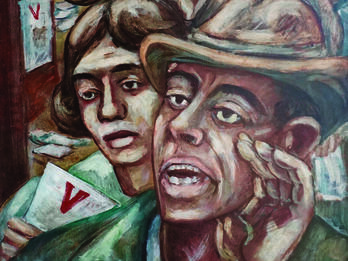Post-Holocaust Jewish Cultural “Spaces”
Postwar Jewish communities created new spaces globally, as American Jews moved to suburbs, Israel established sovereign spaces, and a new European Jewish identity emerged.
In the journey through the geographic centers of the postwar Jewish world, readers encounter different forms of Jewish space: real, imagined, and remembered. In addition to Yiddishland (the Yiddish-speaking diaspora), we find the shtetls of Eastern Europe, the mellahs or Jewish sections of North African cities, the ghettos in Nazi-occupied Europe, the displaced persons’ camps of Germany and Austria, the ma‘abarot or transit camps in Israel, and the old Jewish neighborhoods of New York, Paris, Salonika, and Baghdad.
New Jewish spaces also reflected far-reaching economic changes that especially affected communities in North America and Western Europe. In the postwar years, prosperity replaced economic depression, and millions of Jews in the Americas, Western Europe, Latin America, Australia, and South Africa moved into the middle class. At the same time, formerly prosperous communities, such as the many once well-to-do Jews of Aleppo and Baghdad, found themselves struggling to gain a new foothold in Israel.
In the United States, Jews moved to the suburbs and created new institutions—Jewish community centers and synagogues—that reflected a transition from immigrant ethnicity to a more comfortable Americanism expressed through outward religious observance and vicarious Zionism. In these postwar years, synagogue architecture and new Jewish community centers became a salient form of American Jewish expression and self-confidence even as they reflected the changing needs of Jews on the suburban frontier. One striking example was the new Congregation B’nai Israel in Millburn, New Jersey, where Percival Goodman joined forces with Robert Motherwell, Adolph Gottlieb, and Herbert Ferber to bring together architecture, design, and sculpture in a new affirmation of faith in an American Jewish future.
Jewish geography now included, for the first time, sovereign space: places like Jerusalem, Masada, Tel Aviv, the kibbutz, and the Negev acquired a new resonance as symbols of the Jewish past, of Jewish heroism, of a pioneering future, of an exciting and lively all-Jewish city. This sovereign space included innovative memorials to the war dead, the Israel Museum, built to symbolize the continuity of Jewish presence in the land of Israel, and Yad Vashem, to remember the victims of the Holocaust, as well as the Knesset, the symbol of Jewish statehood.
By the early 1960s, another form of Jewish space slowly began to emerge: a “Europe” with its own distinct Jewish identity, neither American nor Israeli, committed to a Jewish future that transcended past betrayals and disappointments. In a 1971 symposium, one participant wrote that, for the first time, “one could think of European Judaism as one entity, and . . . consider that all the Jewries of Europe could be united by a new idea and by a new creation.”1 That search for a new European Jewish identity also rekindled a determination to retrieve and protect the legacy of German Jewry, such as the founding of the Leo Baeck Institute in New York, London, and Jerusalem.
Clearly, in the postwar era, apart from the Holocaust, Jews worldwide would share no one “usable past.” While the retrieval of the lost legacy of German Jewry became an important priority for certain historians and religious thinkers, especially in the United Kingdom and Europe, many American Jews would turn toward an idealized image of an East European Jewish past, whereas Israel would craft a vision of the Jewish past based on a Zionist narrative of a parlous diaspora existence ultimately redeemed by a return to the homeland.
In the wake of the destruction of East European Jewry and the uprooting of Arab Jewry to Europe and Israel, older terms such as Ashkenaz and Levant acquired new meanings. On one level, they connoted lost worlds that still somehow lived on, cultural universes that spanned national boundaries and drew energy from a paradoxical interplay of Jewish inwardness and ongoing engagement with the non-Jewish world. Scholars, authors, and philosophers responded to the destruction of European Jewry with evocative descriptions of the spiritual, social, and linguistic moorings of an Ashkenaz whose legacy demanded remembrance and study. In the United States, this evocation of collective memory and covenantal space encouraged a recasting of the idea of place in American Jewish identity, the growing fascination with the Lower East Side being a prime example.
In a similar gesture, others reacted to the demise of Arab Jewish culture by proudly turning what had been a pejorative term, the Levant, into a badge of honor. Levantine identity—poised between East and West, between Arabic, French, Hebrew, Spanish, Italian, and English—was marked by hybridity and the fluidity of cultural boundaries. To embrace it constituted an act of both self-assertion and resistance. It reflected pride in one’s heritage and resistance to the attempts of European Jews in Israel to demonstrate their superiority and to impose cultural hegemony. Other Jews uprooted from the Arab lands describe a complicated search for identity as they navigate the shifting valence of “French,” “Arab,” and “Jewish,” and experience serial disappointments in abstract humanism, European liberalism, and an Arab nationalism that promised but failed to include Arabic-speaking Jews.
Notes
“The Rome Colloquium,” European Judaism: A Journal for the New Europe (Summer 1972): 10–29.



